We would like to thank Larry and the TCC Exposure Club for inviting us to speak to their group last Wednesday. We had an enthusiastic crowd, with plenty of questions and discussion about big cameras and black & white film.
JB

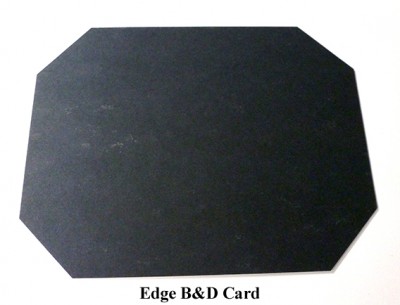 I keep harping on the same old line, but it is true that everyone has their own way of doing things and I am no different. But it seems that I continue to get questions about how we work. There seems to be a misconception that when you contact print that Burning and Dodging (B&D) are not possible. That is 100% malarkey! Whether you use a spring back or vacuum frame, the image on the negative is visible against the white printing paper. Burning and dodging is exactly the same as enlarging.
I keep harping on the same old line, but it is true that everyone has their own way of doing things and I am no different. But it seems that I continue to get questions about how we work. There seems to be a misconception that when you contact print that Burning and Dodging (B&D) are not possible. That is 100% malarkey! Whether you use a spring back or vacuum frame, the image on the negative is visible against the white printing paper. Burning and dodging is exactly the same as enlarging.
Now having dispelled the myth about contact printing, and understanding things work the same, I find there are two B&D tools I use all the time. Yes, there are times you will have to cut strange shapes to make a particular B&D tool for a certain image. No matter what special shapes I may need, I find two shapes that are universally used most of the time.
By far my most used B&D shape is a rectangular piece of mat board. I use this for edges, sides and most any other large areas. The second most used B&D shape is a specially modified rectangle for edge burning. I seem to forever need to burn all four edges of most prints and why burn each edge one at a time? I cut a piece of mat board smaller in both dimensions than the print I am making. Then I cut off all four corners at a 45 degree angle. This is my Edge B&D tool and it sees a lot of use. I can burn all four sides of a print in one exposure. The farther you hold the tool from the print, the larger the area that is held back. Moving the Edge B&D card either in a slow circular motion, or moving slowly up and down, yields a nice even edge burning all the way around the print.
I mostly print 8×10 and 11×14 negatives, and I mostly contact print, so I have two Edge B&D cards for those size prints. I use a custom handle to hold dodging shapes fashioned after Fred Picker’s Lawton Dodger. Most of the time, I have my Edge B&D card taped to my dodger.
This is something to think about and may work as well for you as it has for me. And, this is not just for contact printing. It works equally well for enlarging. Try making your own Edge B&D card, you may like using it!
JB
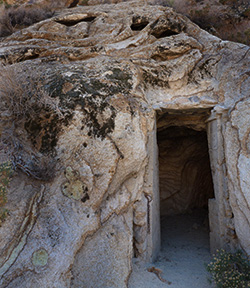 We went on another December and early January expedition to the Southwest again this year. This time we trekked to California and the Eastern Sierra, then backtracked to Utah to visit some of our favorite places to photograph. We saw mild weather and very cold weather on our journey. We had blue skies, cloudy skies, rain and snow. Susan and I shot a lot of film, and now it is time to get the notes in order and begin the darkroom work.
We went on another December and early January expedition to the Southwest again this year. This time we trekked to California and the Eastern Sierra, then backtracked to Utah to visit some of our favorite places to photograph. We saw mild weather and very cold weather on our journey. We had blue skies, cloudy skies, rain and snow. Susan and I shot a lot of film, and now it is time to get the notes in order and begin the darkroom work.We photographed 20 days of the 30 days we were out. We drove 4,102 miles and made a lot of snapshots. HERE is our latest trip album. . . enjoy!
JB
 Let me begin by qualifying what I am about to discuss by saying that I am a traditional B&W photographer. I shoot film and print in a wet darkroom using traditional materials and techniques. Whenever I talk about photography, I am talking about traditional B&W. I know little about color photography and even less about digital.
Let me begin by qualifying what I am about to discuss by saying that I am a traditional B&W photographer. I shoot film and print in a wet darkroom using traditional materials and techniques. Whenever I talk about photography, I am talking about traditional B&W. I know little about color photography and even less about digital.
I have often heard the argument that traditional B&W is so complicated. I actually heard that from several old-time wet darkroom color photographers. The truth is, working with traditional B&W, wet darkroom materials is very simple. But, there is sometimes a complex deception in simplicity. Keep in mind that the most complex machine, or procedure ever devised is little more than a lot of simple things all working together to create a seemingly complex outcome. True, as you add more steps, each step can interact with the others, but if you break each piece of the greater puzzle into less complex, bite-size pieces, it is understandable and controllable.
When it comes to traditional B&W photography, you only have four basic controls to worry about. There are only four simple things that have power over the major aspects of the end product. . . the B&W photograph.
 I ran onto an article by David Vestal published in an old Photo Techniques magazine from 2002 that seems to sum things up very well.
I ran onto an article by David Vestal published in an old Photo Techniques magazine from 2002 that seems to sum things up very well.
“Some people say that we should never crop photos. They’re wrong. When cropping will help the picture, it’s better to crop it than to leave it uncropped. If it doesn’t help the picture, then why bother? But it is an option, and it’s not a moral issue. We don’t need anyone’s permission. If you do it, do it well.” *
I couldn’t have said it better. . . thank you Mr. Vestal!
JB
* David Vestal, Advanced B&W Printing, Photo Techniques Magazine, 2002
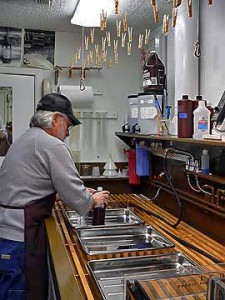 NOTE: I wrote this little rant over a year ago and never published it. Guess it got lost among all the other posts and I have just resurrected it today. I know I am repeating some things here, but I do so only to make my point. My views have not changed.
NOTE: I wrote this little rant over a year ago and never published it. Guess it got lost among all the other posts and I have just resurrected it today. I know I am repeating some things here, but I do so only to make my point. My views have not changed.
I am forever asked, why the wet darkroom? Why would you want to work with film and photographic paper when you can just click the mouse and let the magic box (computer) create a visual paradise? I am perpetually searching for the answer. . . an answer that makes sense to me, and at the same time explains why to those that ask. I have to begin by saying that nothing is ever as it is advertised. Those that have something to sell always tout how easy it is when you buy their products. If you are looking for quick and easy, then photography may not be for you, matters not what the hype says. In all of those slick commercials and magazine ads things just fall into place without any effort. Everyone has a big smile on their face and all is well. Can this be reality?
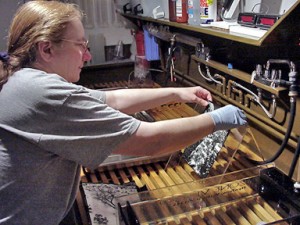
A lot of what we see today is a continuation of the biggest lie ever told about photography back in the early days of the medium. George Eastman, founder of Eastman Kodak Company, came up with a catchy slogan when he introduced the Kodak camera in 1888. His little box camera was the first camera intended for the general public and his slogan was simply, “You Press The Button, We Do The Rest.” This catch line implies that the person making the photograph need do nothing but be there, of course with a Kodak camera, and that person need know nothing, nor do anything, other than press the button and send money to Kodak. This slogan was a work of sheer genius. It made photography easily accessible to the general public and made ‘ol George very wealthy. There is absolutely nothing wrong with any of this, except for that little phrase, which implies that the operator hardly even be present. Anyone that has used a camera knows for themselves that there is more to it than just pressing that little button.
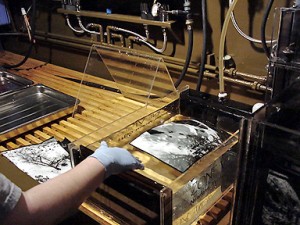 Now I can mention the next biggest lie ever told about photography, this one somewhere in the early 21st century. I am not sure exactly where this came from, but I venture to say it came from large corporate marketing gurus, better known as Harvard MBA’s. When you have large companies run by people that know nothing about the products they produce, you have idiots at the helm. They worship at the altar of the share holders and the quarterly report. Enough said! The next big lie in photography is, “Film Is Dead.” I still believe this was nothing but a marketing ploy to guide the easily persuaded customer to purchase more equipment and new technology. This time based on the layman’s misunderstanding that the computer can do anything with only the click of the mouse. You need do nothing, but supply the money. The old slogan could have been upgraded to read, “You Press The Button, The Computer Does The Rest.” I believe that by now, anyone that has tried this knows, again from hard experience, that it just isn’t that easy. No matter what the hype from any manufacturer, there is no quick and easy way to photographic success.
Now I can mention the next biggest lie ever told about photography, this one somewhere in the early 21st century. I am not sure exactly where this came from, but I venture to say it came from large corporate marketing gurus, better known as Harvard MBA’s. When you have large companies run by people that know nothing about the products they produce, you have idiots at the helm. They worship at the altar of the share holders and the quarterly report. Enough said! The next big lie in photography is, “Film Is Dead.” I still believe this was nothing but a marketing ploy to guide the easily persuaded customer to purchase more equipment and new technology. This time based on the layman’s misunderstanding that the computer can do anything with only the click of the mouse. You need do nothing, but supply the money. The old slogan could have been upgraded to read, “You Press The Button, The Computer Does The Rest.” I believe that by now, anyone that has tried this knows, again from hard experience, that it just isn’t that easy. No matter what the hype from any manufacturer, there is no quick and easy way to photographic success.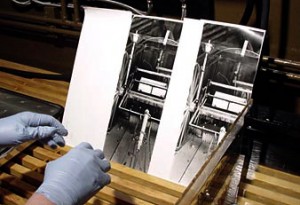
Having said all of this, I feel that the art of photography is something that requires dedication and perseverance. You have to choose your tools carefully and make sure you have the correct tools for your creativity. I have my own opinions as to the validity of what I do and why I do it in a way that suits me. For what I am about to say I have been belittled, scorned, laughed at, and cursed. Makes no difference to me. Anyone small-minded enough not to accept and respect my choices make no difference in the grand scheme anyway. My father used to say that people that use curse words have a narrow vocabulary and an even narrower mind. So my favorite description as to the validity, use, and purpose of digital imaging. . . there I said that word, Digital. . . is to simply say, “It Is Only Another Art Form.” Simple as that! Choosing the wrong medium will turn into nothing but a waste of your time.
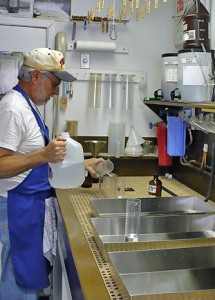 Digital imaging is not a replacement for anything. It is its own entity, has its own strengths and weaknesses. If you choose to work in the Digital arts, good for you! If you are a hybrid photographer, shooting film, scanning and printing digitally, then great for you! If is suits you and you are happy with what you create, then that is just fine with me. If whatever you create suits you, no matter what the medium, then you are on the right path. But, whatever you do, Do Not belittle me for not buying into the farce that Digital is a replacement for Film! And please do not propagate this lie to others that are new to photography. You are doing them a great disservice by funneling them into believing there is only one path. Nothing is more degrading and discouraging than to find out, much later, that you could have done something else that was much more to your liking. People need choices, and need to be able to see all of the different options that are available in the world of photography. One size does not fill all.
Digital imaging is not a replacement for anything. It is its own entity, has its own strengths and weaknesses. If you choose to work in the Digital arts, good for you! If you are a hybrid photographer, shooting film, scanning and printing digitally, then great for you! If is suits you and you are happy with what you create, then that is just fine with me. If whatever you create suits you, no matter what the medium, then you are on the right path. But, whatever you do, Do Not belittle me for not buying into the farce that Digital is a replacement for Film! And please do not propagate this lie to others that are new to photography. You are doing them a great disservice by funneling them into believing there is only one path. Nothing is more degrading and discouraging than to find out, much later, that you could have done something else that was much more to your liking. People need choices, and need to be able to see all of the different options that are available in the world of photography. One size does not fill all.
I realized I still have not answered the question, why the wet darkroom? All I can honestly say is, this is my choice. This is what I choose to do with my life. I can also say without reservation, that for me, a computer screen, keyboard and mouse comprise a place to work. This is where I go to get things done, find information, communicate, write (like this little rant) and to get my days work accomplished. This is not a place for me to create art. There is nothing artistic for me in front of a digital display. I do not feel anything artistic sitting at my desk, and creating art does not happen if I am not in that mood. I see the computer as a place for 100% left brain activities. When I go into the darkroom and close the door, I am immediately in right brain mode. This is where I create. Same as when I duck under the darkcloth behind that view camera. That little LCD screen on my snapshot camera is just for record keeping. There is nothing artistic there for me either. This is how I think. This is how I work. And this is the best I can do to describe why. If you find digital motivating and productive, then by all means use it to your best advantage. I find nothing about it in any way creatively stimulating for me. That is my choice. Do not belittle me if you do not agree. Creativity is fragile and is only where you find it. Use it wisely!
One more thought. I am not on a crusade to convert the world to film. I am only on a quest to try and show everyone that there are choices. . . that the wet darkroom is still alive. If you are interested, you can still choose the medium that best suits you. Matters not whether it is the mouse or the photo tray. What is really important is that everyone knows there is a choice and they should be aware of the strengths and weaknesses of each. To be boxed into that one size fits all world is not good for anyone. Hopefully by now you understand why I choose to work in the wet darkroom.
And, one more final thought. Just in case you believe the hype that film is gone forever, take a look at my earlier post titled, “FILM IS NOT DEAD.” You can special order both B&W and Color film in any size imaginable! No matter what photographic medium you use, the next time someone asks you about photography, do not propagate the lie that film is dead.
JB
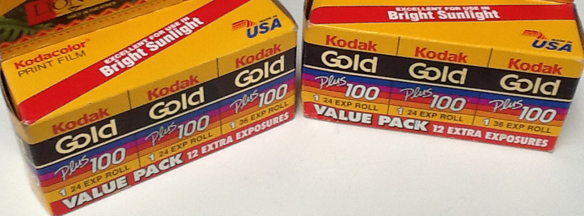 We had a fun time today at the Grapevine Camera Show. Actually found several things that we didn’t already have laying around. Funny how many things are FREE. . . especially when related to film and darkroom. A full bottle of selenium toner, and a near full bottle of Photo-Flo, and six rolls of very old 35mm film for David’s darkroom workshop.
We had a fun time today at the Grapevine Camera Show. Actually found several things that we didn’t already have laying around. Funny how many things are FREE. . . especially when related to film and darkroom. A full bottle of selenium toner, and a near full bottle of Photo-Flo, and six rolls of very old 35mm film for David’s darkroom workshop.
You never know what you are going to find. There have been times we have walked out without a thing to carry home, but not today!
 This is an interesting question that comes up all the time and seems to keep reoccurring. When will you give up film photography and move to digital, is something that is asked of me from time to time? My answer has been consistent since digital photography moved into the mainstream. Personally, my answer is, “I will give up photography completely if I have to go digital.” Plain and simple. . . I will never be able to create serious art with a computer.
This is an interesting question that comes up all the time and seems to keep reoccurring. When will you give up film photography and move to digital, is something that is asked of me from time to time? My answer has been consistent since digital photography moved into the mainstream. Personally, my answer is, “I will give up photography completely if I have to go digital.” Plain and simple. . . I will never be able to create serious art with a computer.
My entire life has been spent in and around the electronics world. I began using a computer when the first Commodore Vic 20 hit the market. I had to learn computing in order to stay current in the engineering world. I see a computer as an engineering tool. It is not a toy, not a game machine, not a source of entertainment. It is a tool for designing complex machines and circuits. . . for navigating to the moon, and the stars. One thing is certain for me, it is not a device for creating my art.
I use a computer for work; I use it to write; I use it to access the Internet; I use it to communicate with others; I use it to update my BLOG; and I use it to host a web site. These to me are not artistic endeavors.
In my mind, a computer is not where I go to express myself visually. It is not where I go to create my art. In front of a monitor I am in a working mindset, mostly thinking in left brain mode. Creativity requires a catalyst. Only out in the field with my camera under the dark cloth, or in the darkroom does my mind really shift into right brain ‘creative’ mode. It is impossible for me to think in an artistic manner when clicking a mouse and looking at a monitor.
I know I have written about this before, but the same question keeps coming up, and my feeling about the subject does not change. This is how I work and how I think. The creation of art is a very personal thing and requires you think in a particular way. For me, I can only create when I am in the proper environment, and cyberspace is not the proper environment for me.
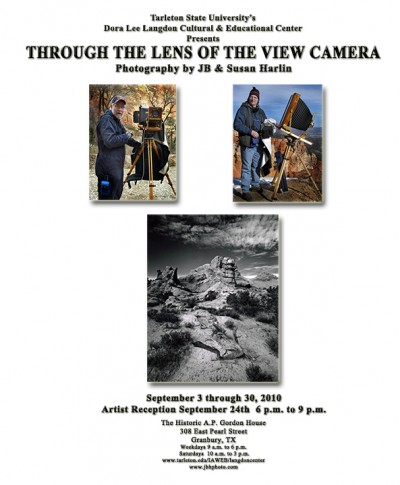 “THROUGH THE LENS OF THE VIEW CAMERA” is an essay originally published in the 2010-2011 “LANGDON REVIEW OF THE ARTS IN TEXAS” published by Tarleton State University’s Dora Lee Langdon Cultural and Educational Center in Granbury, Texas. This was in conjunction with an exhibition of our photography by the same title in 2010.
“THROUGH THE LENS OF THE VIEW CAMERA” is an essay originally published in the 2010-2011 “LANGDON REVIEW OF THE ARTS IN TEXAS” published by Tarleton State University’s Dora Lee Langdon Cultural and Educational Center in Granbury, Texas. This was in conjunction with an exhibition of our photography by the same title in 2010.A PDF version of the essay is available for download in the ARTICLES area of our web site. Scroll to the bottom of the page and click on the link there, or go directly to the PDF HERE.
JB